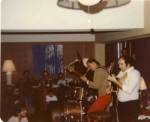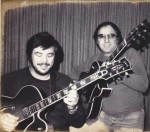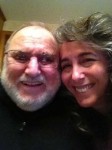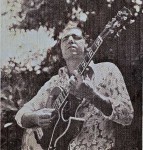
When I was in my early 20s and came to Los Angeles to attend what was then called Guitar Institute of Technology (now Musician’s Institute), one of the people I heard here that blew me away the most was Joe Diorio. When we decided to do a series of interviews here at JGS, one of the people I knew I wanted to interview was Joe, because as far as I knew no one had ever done one, which was amazing for such a stellar player. Here is the interview from Jan. 28, 2013:
DP: What was it that made you decide to become a musician? Was it any one event, or a series of them? What made you decide on the guitar?
JD: First of all, my father played guitar a little bit, and my uncle was an accomplished banjo player and mandolin player, and he played a little guitar so I was hearing music everywhere since I was a little kid, you know? And especially the stringed instruments, I was automatically attracted to them. And then there was a kid in the neighborhood who played accordion, and so I was wondering what kind of an instrument would be best to play with the accordion, and his father said well, guitar, so that’s when I started my lessons.
DP: So how old were you when you started?
JD: Well, I started my lessons at about 13, but I actually started to listen to music when I was very young. When I was about six or seven my father made a deal with somebody where he got a record player with a whole bunch of jazz records with it from that era, so I was listening to music a long time before I even started to play it. And I was listening to jazz of the day, the boogie woogie, Benny Goodman, Artie Shaw, those kind of guys, you know, Django Reinhart. So I had a good shot at listening when I was very young and it helped me to listen a lot better when I got older because I could hear the movements, and I wondered why and then I realized I was hearing them all of my life, you know?
DP: So, what was the history of your musical travels around the country? I know you were born in Waterbury, CT, right?
JD: Well, I was born in Waterbury and I stayed in Waterbury until I was 20 or 21 years old, but I started (playing professionally) with a group out of New York, they did some traveling around, and it was a show business kind of group, you know? A guy and girl singer, three saxophone players and a guitar and bass and drums, and it wasn’t very musical but it got me out of Waterbury and so I started traveling around and got some experience. The thing about it is that didn’t last a long, long time; but we ended up in Cleveland and they said, “Well, we’re breaking the group up†and I said “Well, that’s great, you know – what am I going to do now?†(laughs). So I had a cousin that lived in Chicago and so I called him and said “So can I come and stay there?†and he says, “Yeah, come onâ€, so that’s how I ended up in Chicago.
DP: So the New York gig just happened by somebody knew somebody?
JD: Very early in my life I have made a trip to Las Vegas with a group and I wasn’t even twenty one I think and I met some people, and of course you know how connections go when you meet people and they know other people, and so these people in Vegas that I met knew these people in New York that needed a guitar player, so they contacted me and that’s how I got together with that group in New York.
DP: OK, so then you hit Chicago, and then what happened?
JD: Well, I was in Chicago a long time, maybe seven or eight years, and I played with Eddie Harris and all the great ones, I made recordings with Harris and made recordings with Sonny Stitt and Benny Green and in fact, Eddie Harris’ “Exodus To Jazz†was the record I was on and it was like a big hit, you know, and it was my first record! (Laughs)
DP: Really, your first record? Wow!
JD: Yeah, right, talk about being nervous!
DP: So how did you get the gig with Sonny?
JD: The gig with Sonny…my friend Eddie Buster was playing organ at this club on the south side of Chicago, it was called McKey’s Disc Jockey Lounge, and what they did was they would bring in stars all the time, so Eddie hired me to play with him. And they brought in Stitt and Benny Green and people like that, you know, Gene Ammons – and we would back them up.
And then one night Sonny came in and said “Look, we’re going to do a record in the morning, you know, be there at nine o’clockâ€. So we did that one and we did another one with him after that -we did a follow up – so I did two records with Sonny Stitt.
And I was playing with him every night for weeks and that was an incredible experience, I used to go home at night after the gig – which ended quit late – and I would stay up for hours trying to imitate his lines, and try to remember them and practice them and try to get that feel that he had, you know – I loved it.
DP: That’s the way to do it, when it’s fresh in your mind.
JD: Well, it was for me like going to the best university in the world, I got everything I needed right in Chicago. All the great players, all the questions you could ask, these guys knew the answer to. And just listening to all of these professional type guys like Von Freeman – people like Billy Wallis, people like Jodie Christian, I mean like, these were accomplished musicians, man.
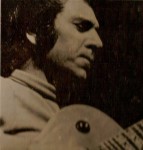
DP: No doubt – so the next place you went was Florida, is that correct?
JD: No – the next thing that I did was that while I was in Chicago starving per usual, one of my friends, Frank Shay, a drummer, got a call from one of the Trenier Brothers – Milt Trenier – and he said “look, we’re doing this little boy / girl pop kinda thing, do you want to take this gig?†and I said “yeah†and so I started doing that. Von Freeman was in the band too, and Eddie Baker was playing piano, so it was piano, bass, drums, guitar, tenor, and the boy and girl singer.
So we traveled around, we went all over like Cuba, the Bahamas, our west, up north, every place; so I stayed with them a long time. And finally I left them and I went back to Chicago, but things were weird in Chicago at the time and I wasn’t finding much work, so I got another gig with a fella by the name of Vic Caesar out in Arizona, so I went all the way out to Arizona to play with him, and a fella by the name of Daniel Long was plying piano; and it was a good little group, you know, and we lost the gig for some reason, and so we ended up in Vegas, and after a couple of months in Vegas I got really sick of all that. While I was traveling I saw Ira Sullivan in Florida, you know, so I thought “boy, I would like to come out here and get on a scene like that where there’s all kinds of great players. So I left the Vegas gig and went all the way to Florida and started playing with Ira and that was one of the highlights of my career. Playing with a master musician like that, you really learn what it’s all about, you know?
DP: I know Ira Sullivan was an amazing multi-instrumentalist, what would you say were the main things you learned from playing with him?
JD: Well, there were a lot of lessons, let me see if I can pin point a few of them for me – first of all, learning how to play the melody really clearly and really learning how to fill in around the melody – learning how to get the biggest, fattest sound you can out of the melody, that’s the starting place when you’re playing tunes, you know? And I realized that I didn’t even know the melody to many of the tunes I played, I know the chord changes, but I didn’t know the melody. And so many times Ira would say “you take the lead†and I realized how many leads I didn’t know, so I started working on learning the melodies, trying to improve my sound, trying to improve my fills, you know?
Of course, Ira could play all kinds of tempos so I learned how to play fast with him – you know, he puts you right through the wringer right off the bat! (Laughs) There’s no excuses man, you just gotta jump up and do it. And it wasn’t only Ira, there was guys like Tony Costallano were there, and Wally Cirillo, and Tony’s brother Dolphy Costallano, and there was a lot of great guys and a lot of great stuff, and that’s then I started to experiment with the outside stuff, you know?
Actually, I started with that in Chicago because Eddie Harris was really proficient at that, and I remember that we were sitting at his house one time, and he had this Slonimsky book up on the piano, and I took one look at that and said “Well, if this is the next step, I gotta wait a long timeâ€, this is some heavy stuff, you know?â€. But eventually I go the book and started working out of it and eventually I got the understanding of how to do some of those things.
DP: Speaking of that, I remember when I was coming in as a student at GIT and you were playing the orientation concert and I remember what went off in my head was “I knew somebody played like that somewhere!â€
JD: (Loud Laugh)
DP: Yeah, so I wondered how you happened to get into all the intervallic stuff…
JD: That’s how it happened, Eddie Harris got me into all of that stuff. He had the book and then I got the book and it actually sat on the shelf for like two years before I started in on it, it was like “I’ll do it next week, I’ll do it, I’ll do it†and then finally one day I finally pulled it out and started learning, and that really threw my head, because it helps you to hear better all kinds of weird fast stuff. I mean, a lot of people think it’s bullshit, but I love it man.
DP: Exactly! Now, I was just sent a picture of you playing with Jaco Pastorious at what I think was the 1977 NAMM show, which would obviously be after he joined Weather Report. It’s widely known that you played with him before that while you both were in Florida but I don’t think that many people know the details – how you met him, where and what you played together, and all that stuff.
JD: Before Jaco became a star, he was just one of the local yokels, man; and he was hanging around with all of us, Ira and all that, you know, just part of the clique there. And he used to ask me all of these questions like how was making all of these intervallic runs and what not, and I told him, “well, you gotta get Slonimsky’s book†(Nicolas Slonimsky’s 1947 classic “Thesaurus of Scales and Melodic Patternsâ€), and he did, and he would ask me a lot of questions about who I was listening to, you know, and I was listening to the Stravinsky’s, the Bartok’s, Ravi Shankar, and all of those guys.
And we would play from time to time, and you know what, when he did this famous “Donna Lee†thing, you remember that?….
DP: Of course…
JD: And like I said before he was famous he was playing it, before he recorded it, but he didn’t have the right fingering. And he asked me about that and I told him, “You know what, it kicked my ass too, but here’s the one I useâ€, and it helped him so I feel like I helped him somewhat, but he always asked me questions about how I was doing things, how I was going outside, and all that, but of course I was new at it too; so I was just telling him what ever I could, whatever I could I gave it to him, you know?
By the way, there’s a sensational record coming out soon – or maybe it’s already out – something we did at the Playboy with Ira, myself, Jaco, Steve Bagby, and Alex Darqui – it was a quintet.
DP: What year was it?
JD: I don’t know, but just before Jaco made it, you could go by the time line….but it’s absolutely incredible, it’s got a couple of Jaco’s tunes on it, a couple of my tunes; and everybody is really outdoing themselves on this record.
(I looked for this record and couldn’t find it but saw a string with both Ira Sullivan and Ingrid Pastorious saying that there is a bootlegged version from Japan called “Green Lightâ€, so do not buy that version if you want this CD – DP)
DP: There’s not that many guitarists of your stature that really devoted a lot of time to teaching, but you have tens of thousands of musicians all over the world that look up to you as a mentor and teacher – there was a long scroll that people signed at the recent MI Alumni Reunion that was covered full of people writing their thanks to you. Can you talk a bit about your experiences in music education?
JD: Well, first of all let me say this and it might seem very strange and your readers might not want to hear this, but I never wanted to be a teacher, I just wanted to be a player, that’s all I had in mind. All I thought about was just being a player all of my life, I never thought that I had the capabilities of being a teacher – I didn’t know the first thing about it to tell you the truth.
When I ended up in California somehow, I met Pat Hicks and Howard Roberts, and at this time I didn’t teach at all, so they were throwing me a few seminars here and there, and a few students, and then I got used to it and then they started the school. So when I started at the school GIT or MI or whatever you want to call it, I didn’t know anything about teaching, so I decided that I all I would do is what I know. I’m not going to go through any systems, I didn’t try to use Howard’s system, I never liked it – and whatever system I used was my system, and that was more or less how to play, as opposed to playing some other things that I’ve hear students do that get you absolutely nowhere.
JD: So that’s how I started teaching, I had a room where I had a desk so I started writing out chord solos for guys, I started writing out lines, I’m sure you know, you were in some of those rooms, you know…
DP: Yup!
JD: …and I used to present all this kind of music to them so that they could get the feeling what PLAYING was all about. And I learned a lot because I was around a lot of good players, there was guys like Don Mock and Ron Eschete, and guys like yourself, you know, who could already play when you came in, and whoever came through the school – I mean, everybody came through there to do concerts, you know – just learning stuff, you know, it helped me to be a better guitar player.
Then the Japanese guys came over and they threw us out, you know, the jazzers, literally – no bonus, no thank you….so fortunately, I was doing a little teaching at USC (University of Southern California), so they asked me to go there, and they were very nice to me, and so I stayed there for the rest of my career until I had my stroke.
DP: Yeah, I know about your stroke and want to get to that in a minute here, but speaking of your students, I know that the last recording you’ve done to date was “The Color of Sound†with Musician’s Institute grad David Becker….
JD: Yeah, that was a beautiful record….
DP: So, what do you think are your definitive recordings that would really show someone the real range of your musicality?
JD: Wow…..(chuckling) well, I started out with Ira (Sullivan), we’ve got a couple of things out there, I did a couple of “space cadet records†with Wally Cirrillo, I did a straight ahead record with Steve Bagby and myself called “Straight Ahead to the Lightâ€, I recorded with Sonny Stitt, I recorded with Eddie Harris. I did a lot of trio records as I got older and I was working with an Italian company by the name of Ram Records, and I did a beautiful quartet record called “Narayaniâ€, that was my wife’s name; she passed away and I wrote a tune for her and named the album for her. But some of my best playing actually never came out – you know when you’re in a club and you’re playing and somebody records it and man – you know? I’ll get it out one of these days…..I will just say this: anything that you find of mine is decent, I don’t think that I have any bad ones, I listen to them to see what’s the story and they’re all good, actually.
DP: (Laughing) That’s something that not very many people can say….
JD: Well, when I was hanging out with Wes Montgomery, and Wes heard some of my records and he said, “You’re lucky, man, you can record well,†‘cause Wes used to get really nervous in the studios, did you know that?
DP: No, I had no idea…
JD: Oh yeah, he was very nervous in the studio when the red light came on, he told me “yeah, you’re lucky, you can just go in the studio and just play†and I said, “well, who knows why, I just do†(laughs).
DP: Well, it’s probably just an overall life attitude or like that….OK, so I don’t know if you know this, but you’re sort of known for coming up with a lot of your own colorful descriptions of musical devices – I remember the term “Fobiola triplets“ that you used when you were teaching things like the music of Charlie Parker….
JD: (Laughing)…Oh, the story about that “Fobiola Triplet†is that when we were kids we were rehearsing our little group and we were rehearsing at night, you know, and none of us had a car, I don’t even think we were old enough to drive; so we were waiting at a bus stop and this Afro-American guy came by and he had his bass in the car so he asked us what kind of music we played. So we said “jazz’ and he said, “That’s great, do you know your Fobiola triplets?†– and we all looked at the guy like he was nuts – actually (laughing) I don’t think there’s such a thing as a “Fobiola tripletâ€, it was just something that he just said off the top of his head….
DP: I always figured it was a 16th note triplet pattern of a dotted eight, a 16th note, and then three 16th notes….
JD: I guess you could do that….(Laughs)
DP: Well, only that guy way back then knows for sure, I guess (laughs), So, along these lines, our mutual friend Tim Lerch said that I should ask you about the special secret technique you invented called – and I’m going to try to pronounce this right: Ifumamas (“EEF-ya-a-mamasâ€)…..
JD: (long laugh) Ifumamas! Hahahahahahahah…….Well, what I do is that I’m always making up sentences that don’t make any sense – even now I do it: I’ll sing a song to my wife and I’ll make my own lyrics, and my wife will go: “Why are you ruining a good song?†(Laughs) ..but it’s just like a technique of showing someone something musical, you know, “ifumamas, ifumamasâ€â€¦
DP: I get it, the word fits with the rhythm…
JD: It fit’s with the rhythm, yeah (laughs)….it’s like the kid says, “What’s wrong with my playing?â€, and I say “Well, there’s nothing WRONG with your playing, you just lack a lot of ifumamas’s!†(Both laugh big)
DP: That leads me to something, you know….there’s players that just rattle off constant 16th notes and I’ve never liked that. I’ve always wanted to improvise rhythmically as well, and of course you do that great…
JD: Thank you….that comes from the bebop….
DP: Of course – and putting in rests (laughs)
JD: I was coming at the start from the bebop, and so I have a lot of that in me and then of course the other stuff, so the combination is what my style is.
DP: You’ve played with some of the greatest guitarists that there are in jazz, including Jack Wilkins, Robben Ford, Pat Metheny and Mick Goodrick, and of course the amazing teachers who were with you at MI like Howard Roberts, Don Mock, and Ron Eschete – what are the things that you feel makes a great guitar player – is there any through line?
JD: Well, I also played with Jim Hall and Tal Farlow – and Barney Kessell, and Charlie Byrd….
DP: Wow…yes, that sort of runs the gamut…
JD: Well, being at MI helped a lot, and then being at the NAMM show s you meet a lot of people. As far as the tread that goes thought all the guys, you have to go back to the beginning, which is Django (Reinhart) and Charlie Christian. So if you listen to Jim Hall and Farlow and Kessel and all of that, they’re coming out of Christian. Now, some of the guys also had the bop in them, Tal had a lot of that, Jimmy Rainey was a bopper, but he had the Christian thing, you know? Now the younger guys like Jack Wilkins are a little harder to identify and I don’t even know if I can attempt it – maybe the Johnny Smith influence started creeping in about that time – I’m saying maybe.
DP: One time I remember your sticking your head in my practice room when I was working on a Bach Fugue and you saying something like “that’s life music, man†– I’m sure that you’ve studied a lot of other kinds of music in your life than jazz, can you talk a little about that?
JD: Oh yeah, Indian music like Ravi Shankar, also Stravinsky, Ravel……
DP: I’ve heard that you’re an avid reader, can you talk about some of the books that have really effected your music, and maybe tell us what you are reading right now?
JD: I really got into the Buddha and the Hindu thing, and I am a member of the Vadanta Society of California with Shri Rama Krishna and his disciple Vive Kananda. I was heavily into “Autobiography Of A Yogi†and am reading the Bhagavad- Gita in the Yogananda translation.
DP: One of the things that every successful musician has to be able to do is overcome adversity in life, everyone has obstacles that they have to overcome to arrive at being the musician that they want to be, be they monetary, emotional, or physical barriers. I have been really impressed when people have told me at how determined you have been in coming back from the stroke that you had a few years ago, can you talk a bit about that and some the other things you’ve overcome throughout your life, and any life advice you would have for musicians on this topic?
JD: I’d say the main problem I have had in life is making money (laughs), I just never got paid enough for what I did. I liked working at MI and USC but I never got paid enough money, at least in my opinion. But you have to do what you do and it can’t all be about the money, you have to give back. Also, in about 2004 or 2005 one morning I woke up and I couldn’t move my left arm or leg, I found out that I had a stroke and it’s been really hard to come back but I have been doing it. (For more on Joe’s stroke, see the link to Bill Milkowski’s article below)
DP: OK, so all of these questions have been about the past, and I am sure that you are far from done in what you are pursuing in life in any way – can you tell us what your plans are for the future?
JD: Well, I do a lot of things other than music, I do painting and wood sculpture and clay sculpture and I do that all of the time. I try to play guitar 2 hours everyday, I don’t always get to do it but I try. I also write music every day, every day I write tunes and guitar studies and all kinds of things, and I transcribe piano stuff like Herbie (Hancock), Bill Evans and Richie Beirach just to get into what they are doing, because there is just so much more that can go on a piano than a guitar. I write out all these transcriptions for guitar have about 7 guys that come to my house and play each of the different voices so I can hear them all on the guitar. There are some great guys that come to this group that you’re going to hear about because they’re so great like Chris Morrison ( http://www.morrisonguitar.com/ ) and Rich Goldstein (http://richgoldsteinjazz.com/ ).
Another thing that I got into when I was teaching at MI was solo guitar, I got tired of always playing with piano players and bass players and drummers and one of the things I did was that I went all around Europe playing solo guitar, where I used a gimmick of having a slide show of my paintings going on in the back ground. (Wow – so you would play things that were inspired by the paintings as they went by?) Well, I don’t know about that, a lot of times they were going by too fast to react musically to all of them (laughs).
If I could give any advice to anyone musically, it’s that you have to just pick some one thing and stick with it, and don’t let anything get you off track. And you have to give back, if someone wants to know how to play a C chord, show them, don’t keep it all for yourself.
MORE:
Video:
Pat Metheny / Joe Diorio duet “How Insensitiveâ€
Articles/Sites:
http://jazztimes.com/articles/19427-joe-diorio-rehabilitation-reinvention
http://en.wikipedia.org/wiki/Joe_Diorio – mw-headhttp://en.wikipedia.org/wiki/Joe_Diorio – p-search
Discography
• Solo Guitar (Spitball 1973)
• Rapport – with Wally Cirillo (Spitball 1974)
• Solo-Duo – with Cirillo (Spitball 1976)
• Straight Ahead To The Light – with Steve Bagby (Spitball 1976)
• Peaceful Journey (Spitball 1977)
• Bonita (Zdenek 1980)
• 20th Century Impressions – with Jeff Berlin, Vinnie Colaiuta (J Disc 1981)
• Earth Moon Earth (Nocturne 1987)
• Italy (MGI 1989)
• Minor Elegance – with Robben Ford (MGI 1990)
• Double Take – with Riccardo Del Fra (Ram 1992)
• We Will Meet Again (Ram 1992)
• Rare Birds – with Mick Goodrick (Ram 1993)
• The Breeze And I – with Ira Sullivan (Ram 1993)
• Quartet Narayani – with Hal Crook (Ram 1994)
• More Than Friends – with Steve La Spina, Steve Bagby (Ram 1994)
• To Jobim With Love (Ram 1995)
• I Remember You: A Tribute To Wes Montgomery (Ram 1998)
• Stateside (Diorio Jazz 2000)
• Joe Diorio Live (Diorio Jazz 2002)
With Eddie Harris
• Exodus to Jazz (Vee-Jay, 1961)
• Mighty Like a Rose (Vee-Jay, 1961)
• Jazz for “Breakfast at Tiffany’s” (Vee-Jay, 1961)
• A Study in Jazz (Vee-Jay, 1962)
• For Bird and Bags (Exodus, 1963)
• Come on Down (Atlantic, 1970)
With Sam Lazar
• Playback (Argo, 1962)
With Sonny Stitt
• Move on Over (Argo, 1963)
• My Main Man (Argo, 1964) – with Bennie Green
[As a mentor
• The Color of Sound – David Becker & Joe Diorio(Acoustic Music – 2005)
• Alone Together – Eric Leboucher-Radiguet & Joe Diorio (Djazz 2003)
• Under the Influence – Pino Marrone.
